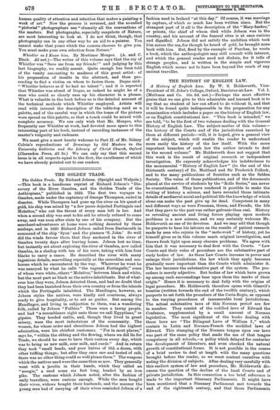.A History of English Law. By W. S. Holdsworth, Vice-
President of St. John's College, Oxford, Barrister-at-Law. Vol. I. (Methuen and Co. 10s. 6d. net.)—Perhaps the most effective praise that we can give to this admirable and learned book is to say that no student of law can afford to do without it, and that it will be found quite indispensable in the preparation for any examination which includes a paper on the history of English law, or on English constitutional law. "This book is intended," we are told, "to be the first of two volumes dealing with the General History of English Law. The subject-matter of this volume— the history of the Courts and of the jurisdiction exercised by them at different periods—will, it is hoped, give a general view of the subject, which will enable the reader to understand more easily the history of the law itself. With the more important branches of such law the author intends to deal in the second volume." Mr. Holdsworth does not suggest that this work is the result of original research or independent investigation. He expressly acknowledges his indebtedness to the monumental "History of English Law" (to the end of the thirteenth century) of Dr. Maitland and Sir Frederick Pollock, and to the many publications of Societies such as the Selden Society. The value of these publications, and of the documents placed at the service of students by the "Rolls Series," can never be overestimated. They have rendered it possible to make the writing of history a science, and have revealed those intimate details of mediaeval social and political life the knowledge of which alone can make the past give up its dead. Competent in many and different ways as were Freeman, Green, and Froude, the life that they gave to the past was rather galvanic than real. History as revealing ancient and living forces playing upon modern problems is a new science, and we may certainly welcome Mr. Holdsworth as one of its devotees. And we may add that though he purports to base his labours on the results of patient research made by men who rejoice in the " mole-work " of history, yet he himself gives us in this volume much original investigation, and throws fresh light upon many obscure problems. We agree with him that it was necessary to deal first with the Courts. "Law Courts and their rules of procedure are the substantive part of early bodies of law. As these Law Courts increase in power and enlarge their jurisdictions, the law which they apply becomes gradually more important than the Courts which administer it. The law becomes the substantive part of the system. The pro- cedure is merely adjective. But bodies of law which have grown up among such surroundings bear upon them the marks of their origin." Hence it is necessary to deal fully with the origins of legal procedure. Mr. Holdsworth therefore opens with Glanvil's treatise (written towards the end of the twelfth century), which purports to set forth the procedure of the Curia Regis, as opposed to the varying procedures of innumerable local jurisdictions. The actual substantive laws of this Norman period are few in number. They consist of the codified laws of Edward the Confessor, supplemented by a small amount of Norman legislation. The most significant of the books dealing with these laws are "The Bilingual Laws of William I.," which contain in Latin and Norman-French the modified, laws of Edward. This stamping of the Norman tongue upon our laws was part of the same policy that made the use of that tongue compulsory in all schools,—a policy which delayed for centuries the development of literature, and even checked the natural growth of constitutional forms. It is not possible in the course of a brief review to deal at length with the many questions brought before the reader, so we must content ourselves with noting the division of subjects. After dealing very carefully with this earliest system of law and procedure, Mr. Holdsworth dis- cusses the question of the decline of the local Courts and of private jurisdiction. In this connection a too brief reference is made to the important Stannary Parliaments. It might have been mentioned that a Stannary Parliament met towards the end of the eighteenth century, and that those Parliaments are still competent to meet despite the Stannary legislation of 1898. Is it not also a fact that there could be joint meetings of these Parliaments ? Mr. Holdsworth next treats of the system of common law jurisdiction ; then he passes to the history of the House of Lords. The history of the Chancery and the Court of Chancery is examined at length, and the value of the chapter can scarcely be overestimated. The development of equitable rules of law will presumably be traced in the next volume,—rule,s such as that against per- petuities, and that creating restraints on anticipation in the case of married women. The history of separate estate will then also be dealt with, we presume ; and we hope Mr. Holdsworth will solve the problem of its origin. It certainly extends (despite the text-books) far behind the reign of Henry VIII. The last three chapters deal respectively with the Great Council and the Privy Council, Courts of a special jurisdiction, the Judicature Acts, and the New County Courts. The Appendix of Forms and Writs is most valuable. We heartily recommend this book to the scholar and the student.



























































 Previous page
Previous page